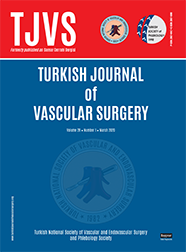
The Turkish Journal of Vascular Surgery
Yazarlar: Ali RAHMAN, İbrahim Murat ÖZGÜLER
Konular:-
Anahtar Kelimeler:Coronary angiography; arterial occlusive diseases
Özet: Purpose: The aim of this study was to evaluate patients operated for aortoiliac occlusive disease retrospectively. Methods: This retrospective study evaluated 55 patients (52 males and 3 females, mean age 55.84) undergoing elective revascularization for aortoiliac occlusive disease during seven-year periods (January 2000 to January 2007). For this study clinical archieves and grafts patencies have been used. Results: Eighteen out of 55 patients had coronary angiography during the preoperative period and 14 patients underwent percutaneous interventions or surgery. Forty-five out of 55 patients had aortobifemoral or aortobiiliac bypass. Also, 23 out of 55 patients had combined infrainguinal revascularization. No intraoperative deaths were recorded, but one patient died on the 4th postoperative day because of abdominal compartment syndrome. Cumulative six months patency rates were 99% and amputation rates were limited by 2 (3.6%) cases of 1 (1.8%) major and 1 (1.8%) minor amputation. Conclusions: Low mortality and effective clinical results can be accompanied with aortoiliac disease if the patients were evaluated precisely in the preoperative period and combined with additional interventions for femoral or more distal arteries.